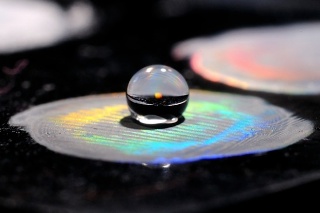Oct 29 2015
Researchers at the University of Pennsylvania have received a five-year, $3.6 million grant from the National Science Foundation to develop materials for multifunctional coatings on emergency tents, enabling them to manage water, prevent the spread of bacteria and capture and store solar energy.
 An example of a superhydrophobic coating from PIRE member Shu Yang's lab.
An example of a superhydrophobic coating from PIRE member Shu Yang's lab.
These disparate capabilities all stem from fundamental research on how materials behave on the nanoscale, where minute structural details can produce large-scale effects.
The grant is part of the NSF’s Partnerships in International Research and Education, or PIRE, program, which seeks to foster global collaborations on topics of societal importance.
The Penn team features dozens of faculty members and students in the School of Engineering and Applied Science, School of Arts & Sciences and Perelman School of Medicine. It is being directed by Russell Composto, Engineering’s associate dean of undergraduate education and a professor in the Department of Materials Science and Engineering. Zahra Fakhraai, an assistant professor in the School of Arts & Sciences’ Department of Chemistry; Daeyeon Lee, an associate professor of chemical and biomolecular engineering; and Kristin Field, director of programs at the Nano/Bio Interface Center are also on the leadership team.
Their project, “Research and Education in Active Coatings Technologies for the human habitat,” or REACT, is principally a collaboration with GIANT, or Grenoble Innovation for Advanced New Technologies, a public-private research partnership based in Grenoble, France, which has received a complementary grant from the French science funding agencies Centre National de la Recherche Scientifique, or CNRS and Angence Nationale Recherche, or ANR. Patrice Rannou, associate director of international research, is the director of the GIANT contingent.
“We have a longstanding relationship for international research experience and student exchange with GIANT,” Composto said. “This grant is going to expand this relationship and organize it around three coating technologies: water management, infection control and energy collection and storage.”
The project is also being conducted in conjunction with COMPASS, the Complex Assemblies of Soft Matter Lab, which is itself a collaboration between Penn, CNRS and Solvay, a multinational company with facilities near Penn and Grenoble. Ryan Murphy, the research and innovation external affairs coordinator for Solvay North America, leads the Solvay contingent.
Penn will also collaborate with researchers at Alabama State University, Villanova University and Bryn Mawr College.
The ultimate goal for the PIRE project is a prototype of an emergency tent that exhibits all three active coating technologies, or ACTs. However, the fundamental nature of the properties they will exhibit mean they could be applied, individually or together, in many architectural contexts.
“These types of coatings can have much broader impacts,” Lee said. “Since they can be sprayed or painted on a variety of materials, they could be used to completely renovate already existing buildings to make them more eco-friendly and energy efficient.”
Members of all of the project’s partner institutions will collaborate on the basic science and industrial design necessary to realize the three ACTs.